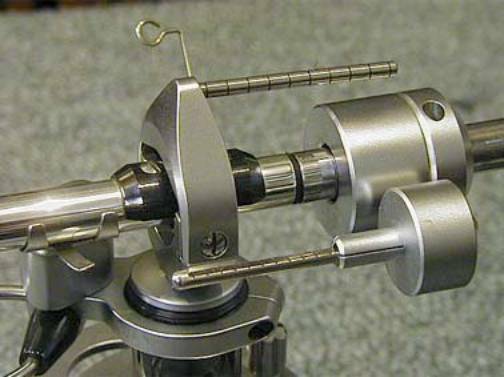
The mechanical and electrical connection from the arm to the carrier and the pickup is not carried out according to the widespread half-inch standard, but according to the SME standard. The carrier for the cartridge is perforated. Due to the principle of the shorter tonearm, the tracking error angle is slightly larger. An effective mass of 12.5 g (3009) or 14 g (3012) is achieved.
SHURE SME TONEARM SERIES
The actual arm is J-shaped and consists of a thin stainless steel tube (thickness 0.25 mm) for the Series I, and a polished, light-anodized aluminum tube (thickness 0.56 mm) for the Series II. There is a boom with a separate weight for the lateral balance. In order to balance the weight of the arm and the pickup, and at the same time to set a constant, reproducible tracking force (typically between 10 and 25 millinewtons, corresponding to 1.0 and 2.5 grams), counterweights are attached to the point protruding over the axis.

In later series the hydraulic oil is also used to dampen vibrations. A small hydraulic hand-operated device is available for this.

In order to be able to lower and lift the pickup with the stylus, the arm can be swiveled in a horizontally mounted bearing. The axis can be adjusted in height by at least 60 mm. When playing, the arm follows the movement around this axis. ConstructionĪs with all conventional (not tangential) tonearms, a vertical axis is attached to a base plate with several adjustment options, around which the arm can be pivoted. The M2-12R is another name for the 3012 and is still produced and sold today.

The product history spans over 50 years without any significant design changes. The tonearm and its successors were or can be bought in specialized stores at four-digit euro prices. The last R version built was heavier and also included a 10-inch long version. 1972, called Series II in the development stage, production ended for the time being, but was later resumed (Improved) and lasted until 2004. Development and start of production are in the late 1950s.


 0 kommentar(er)
0 kommentar(er)
